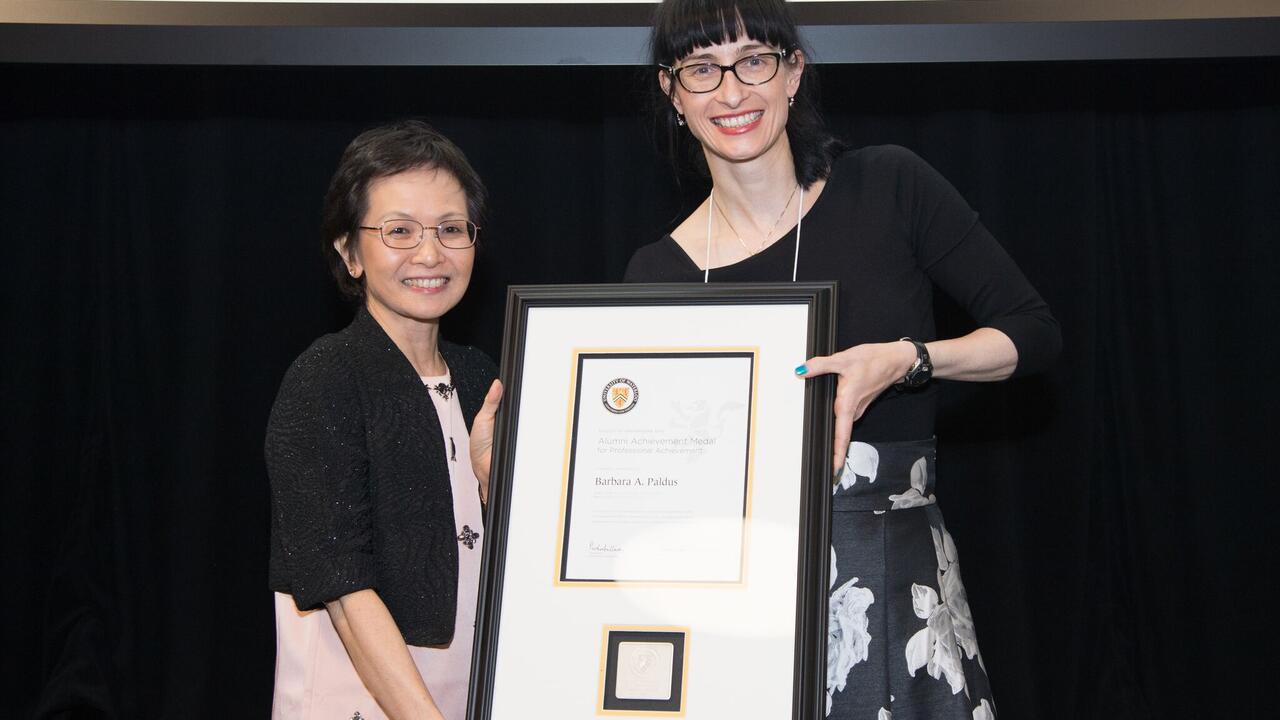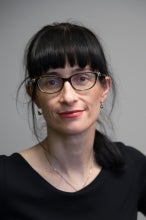
Waterloo Engineering honours its own
Awards’ dinner celebrates top students, distinguished alumni and a Waterloo Region family with a record of generous support.

Awards’ dinner celebrates top students, distinguished alumni and a Waterloo Region family with a record of generous support.
By Brian Caldwell Faculty of EngineeringFuture plans and past achievements were highlighted when hundreds of students, staff, faculty members, alumni and donors gathered for the 2016 Waterloo Engineering Awards Dinner.
The event that recognized top students also celebrated distinguished graduates in four categories and a Waterloo Region family with a record of generous support for the Faculty and the University.
“While the individuals and companies recognized tonight contribute to their professions and society in different ways, they have one thing in common: they have all brought great pride to the Faculty,” said Pearl Sullivan, dean of Waterloo Engineering.
The recipients of the five alumni awards were:
After coming to Waterloo Region from Germany with his wife Penny in 1963, Manfred Conrad excelled in real estate and started the Kitchener-based Cora Group 15 years later. Along with his son Adrian, he was instrumental in the development of the David Johnston Research and Technology Park on campus.
The family’s broad community philanthropy includes a $5-million donation several years ago to the University’s Centre for Business, Entrepreneurship and Technology, allowing it to move into the Accelerator Centre building in the research park.
Renamed in the family’s honour, the Conrad Business, Entrepreneurship and Technology Centre offers entrepreneurially inclined students access to business mentors, networking opportunities and business leaders.
Manfred - who received an honorary Doctor of Laws degree from the University in 2009 for his business and philanthropic leadership - and Adrian Conrad have also mentored and lectured students in the Master of Business, Entrepreneurship and Technology program.
A graduate of Waterloo himself, Adrian Conrad said that “as a family of entrepreneurs, it is special to receive the award from such a renowned university.”
Stressing the family’s passion for sustainable development as well as business, he also outlined ambitious plans with several partners to construct a new building in the research park, starting in the spring of 2017, that will use the latest technology to generate more energy than it consumes.
“We’re going to show the world, show Canada, how you can build sustainably, truly sustainably, in a viable way,” Conrad said.
After hitting on an idea for a tool to track how people watch marketing videos for a fourth-year Capstone Design project, Michael Litt (BASc 2011, Systems Design) and his team won a coveted spot at the Y Combinator business incubator in Silicon Valley.
Litt and Devon Galloway, also a graduate of Waterloo’s systems design engineering program, have since built Vidyard, which provides a comprehensive platform for recording, distributing and analyzing marketing videos. Based in Kitchener, the 180-employee company has attracted over $60 million in venture capital and has more than 1,000 customers worldwide.
Since returning to Canada to build the business, Litt has supported Waterloo Engineering by hiring co-op students as well as recent graduates and alumni. His approach earned him a top employer honour from the University and a 2016 Change Agents award from Canadian Business magazine.
In addition to thanking his family and his alma mater, he used his time at the podium to warn that the brain drain of talented graduates to other countries is still a major problem, urging everyone to do their part to stem the tide.
“It is up to all of us – alumni, students, faculty – to ensure that the students at this academic institution, specifically engineering, understand the opportunities that exist here at home,” said Litt, stressing his belief that information and communications technology is key to the country’s economic future.
Waterloo Engineering graduates Brian Howe (BASc 1984, Mechanical), Bill Gastmeier (BSc 1974, Physics; MASc 1976, Electrical) and Brian Chapnik (BASc 1988, MASc 1990, Systems Design) founded HGC Engineering Ltd, a Toronto-based acoustical consulting firm in 1994, and were later joined by fellow alumnus Rob Stevens (BASc 1992, MASc, 2003, Mechanical).
Their diverse skills and personalities helped them build a worldwide reputation in the measurement, assessment and mitigation of noise and vibration problems, as well as the acoustical optimization of architectural spaces and products.
The majority of the company’s employees are Waterloo Engineering graduates and almost 50 students have been hired for co-op work terms in the last 20 years. The principals have also contributed to the education of students at the School of Architecture and other local institutions.
Speaking for the foursome as president and CEO of the company, Howe credited Waterloo with giving them “a very strong start and a very bright future.” With many students in the audience, he also praised their contributions to HGC.
“Whenever we’ve had a problem that we thought was impossible, we’ve just asked a co-op student to do it – because they’re smart enough to actually achieve it and too young to know it’s impossible,” he said.
After earning an undergraduate degree in India, Romesh Batra went on to complete his mechanical engineering master’s degree at Waterloo Engineering in 1969 and a doctorate at Johns Hopkins University.
A world-recognized leader in the science of the failure of materials under extreme loads, including roadside bombs, he is currently a professor of engineering science and mechanics at Virginia Polytechnic Institute and State University.
During his long academic career, Batra has mentored to completion 34 doctoral and 18 master’s students, while also collaborating on research with 55 post-doctoral fellows. Nearly a dozen of his former PhD students are faculty members around the world.
“I know that if I’m mentoring a student, there is a lot at stake,” he said.
His accomplishments, including an honorary membership award from the American Society of Mechanical Engineers, came after his parents – neither of whom graduated from middle school – sacrificed greatly so he and his older brother could achieve higher educations.
Eager for a challenge when she looked into attending Waterloo Engineering as a 17-year-old, Barb Paldus did a double undergraduate degree in electrical engineering and applied math at the same time graduating in 1993, before moving on to graduate studies at Stanford University.
While at Stanford, she developed a spectrometer a million times more sensitive than existing instruments and set about commercializing her invention after finishing her doctorate. Her cavity ring-down spectroscopy is now used for everything from detecting pipeline leaks to ensuring the bananas in shipments all ripen at the same time.

Paldus switched gears and went into biotechnology as co-founder in 2005 of Finesse Solutions, a Silicon Valley company that developed measurement and control systems for pharmaceutical bioreactors. She is now focused on creating miniature cell factories for immunotherapy, with a goal of extending the lives of people with advanced cancer.
The holder of 21 patents, with 12 pending patent applications, as well as a venture capitalist, she credits Waterloo with teaching her how to both learn and persevere.
“You may be thrown loops, you may be thrown a corner on the path, but as long as you keep that love of learning, that love of discovery and that curiosity, you will always somehow manage to dig yourself out of every hole,” Paldus said.

Read more
Jocelyne Murphy, recipient of the 2025 Pearl Sullivan Emerging Global Leaders Award, is helping students around the world connect, create and lead with purpose

Read more
GreenHouse awards $10,000 to student ventures and changemakers aiming to transform livelihoods within disadvantaged communities

Read more
Velocity and FemTech Canada support Waterloo students to design transformative tech solutions for improving women’s health and well-being
The University of Waterloo acknowledges that much of our work takes place on the traditional territory of the Neutral, Anishinaabeg, and Haudenosaunee peoples. Our main campus is situated on the Haldimand Tract, the land granted to the Six Nations that includes six miles on each side of the Grand River. Our active work toward reconciliation takes place across our campuses through research, learning, teaching, and community building, and is co-ordinated within the Office of Indigenous Relations.